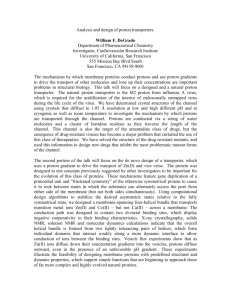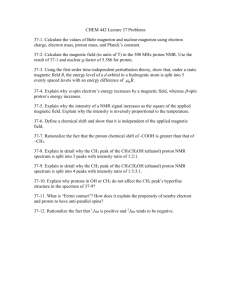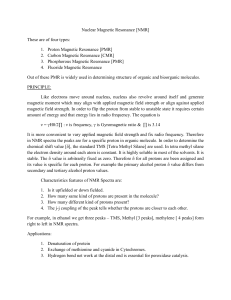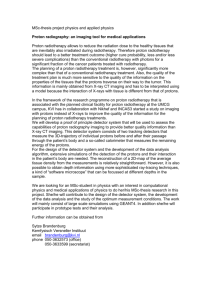Acknowledgements
advertisement
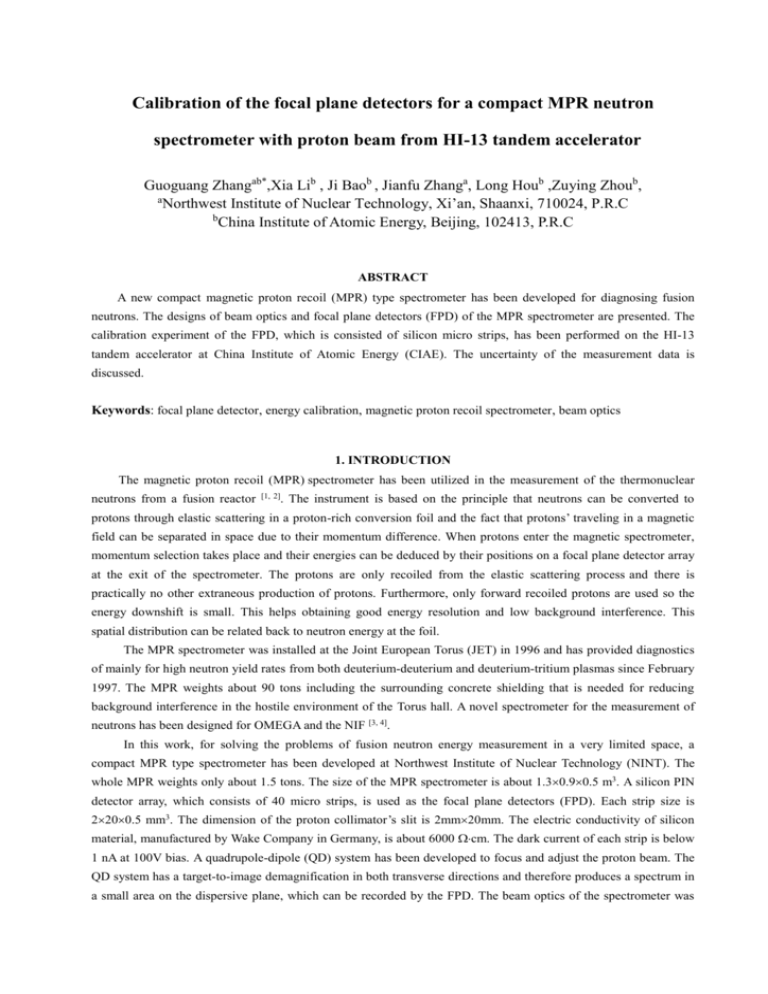
Calibration of the focal plane detectors for a compact MPR neutron spectrometer with proton beam from HI-13 tandem accelerator Guoguang Zhangab*,Xia Lib , Ji Baob , Jianfu Zhanga, Long Houb ,Zuying Zhoub, a Northwest Institute of Nuclear Technology, Xi’an, Shaanxi, 710024, P.R.C b China Institute of Atomic Energy, Beijing, 102413, P.R.C ABSTRACT A new compact magnetic proton recoil (MPR) type spectrometer has been developed for diagnosing fusion neutrons. The designs of beam optics and focal plane detectors (FPD) of the MPR spectrometer are presented. The calibration experiment of the FPD, which is consisted of silicon micro strips, has been performed on the HI-13 tandem accelerator at China Institute of Atomic Energy (CIAE). The uncertainty of the measurement data is discussed. Keywords: focal plane detector, energy calibration, magnetic proton recoil spectrometer, beam optics 1. INTRODUCTION The magnetic proton recoil (MPR) spectrometer has been utilized in the measurement of the thermonuclear neutrons from a fusion reactor [1, 2] . The instrument is based on the principle that neutrons can be converted to protons through elastic scattering in a proton-rich conversion foil and the fact that protons’ traveling in a magnetic field can be separated in space due to their momentum difference. When protons enter the magnetic spectrometer, momentum selection takes place and their energies can be deduced by their positions on a focal plane detector array at the exit of the spectrometer. The protons are only recoiled from the elastic scattering process and there is practically no other extraneous production of protons. Furthermore, only forward recoiled protons are used so the energy downshift is small. This helps obtaining good energy resolution and low background interference. This spatial distribution can be related back to neutron energy at the foil. The MPR spectrometer was installed at the Joint European Torus (JET) in 1996 and has provided diagnostics of mainly for high neutron yield rates from both deuterium-deuterium and deuterium-tritium plasmas since February 1997. The MPR weights about 90 tons including the surrounding concrete shielding that is needed for reducing background interference in the hostile environment of the Torus hall. A novel spectrometer for the measurement of neutrons has been designed for OMEGA and the NIF [3, 4]. In this work, for solving the problems of fusion neutron energy measurement in a very limited space, a compact MPR type spectrometer has been developed at Northwest Institute of Nuclear Technology (NINT). The whole MPR weights only about 1.5 tons. The size of the MPR spectrometer is about 1.30.90.5 m3. A silicon PIN detector array, which consists of 40 micro strips, is used as the focal plane detectors (FPD). Each strip size is 2200.5 mm3. The dimension of the proton collimator’s slit is 2mm20mm. The electric conductivity of silicon material, manufactured by Wake Company in Germany, is about 6000 cm. The dark current of each strip is below 1 nA at 100V bias. A quadrupole-dipole (QD) system has been developed to focus and adjust the proton beam. The QD system has a target-to-image demagnification in both transverse directions and therefore produces a spectrum in a small area on the dispersive plane, which can be recorded by the FPD. The beam optics of the spectrometer was calculated using TRANSPORT [5] and Turtle codes. The bending angle of the dipole is 60 and 14MeV protons can be cast in the central trajectory when the magnetic field is 18 kG . 2. EXPERIMENTAL METHOD In order to test the focal plane of the system, a calibration experiment of the FPD using proton beam was carried out at the HI-13 tendon accelerator at China Institute of Atomic Energy (CIAE). The diagram of the spectrometer is shown in Fig.1. The whole system consists of four parts. The first part is the Au scattering chamber, the second part is the vacuum chamber for proton transport, the third part is the magnetic system and the last part is the focal plane detector. An Au foil is set in the center of the scattering chamber and it can deliver appropriate proton beam without losing much of its energy before entering the proton collimator. The Au target is 10mm in diameter and with a mass thickness of 4.7mg/cm2. The energy of incoming proton beam is 14MeV. Then the scattered protons go through a 2.2 cm long collimator to the magnetic analysis system and are focused on the focal plane detector. As shown in Fig.1, a corrugated tube and the back-to-front equipment are installed to adjust the distance from the chamber to the focal plane. Au target proton dump beam line proton collimator vacuum chamber quadrupole magnetic dipole magnetic proton dump corrugated tube focal plane detector Fig.1. The schematic diagram of experimental system The MPR data are collected by the data acquisition (DAQ) system during an experiment run. In addition to collecting data from the detector, the DAQ is also used to monitor the status of detector array, the DAQ electronics and the dipole magnets. The schematic view of the data acquisition is shown in Fig. 2. CF8000 OR M32 Charge Sensitive Preamplifiers Detectors Bias Preamplifier Power Supply VME DAQ Systam Focal Plane Detector 32 Strips Si-PIN Detectors CAEN N568B 16 Channel Amplifier CAEN V785N CAEN N568B 16 Channel Amplifier DAQ trig CF8000 OR Fig.2. The schematic view of MPRs data acquisition system When a proton hits on the silicon strip of the detector array, the output charge signal, related to the energy deposited in the detector, are fed into M32 charge sensitivity preamplifiers. The output signal from preamplifier is then split into two signals and fed into two CAEN 568B linear amplifiers, which constitutes two separate branches of the DAQ system, one analogue and one digital branch. The digital branch, which possesses high throughput, records the counts of signals (time resolved) by using standard CAEN V785N VME system, which is triggered by the signal from the PS CF8000, fed by CAEN 568B fast output signal. In the analogue branch, pulse height histograms are recorded by using analogue-to-digital conversion (ADC) VME modules. The pulse height histograms are used for off-line background corrections of the data. However, only silicon signals above a given absolute voltage (threshold) are recorded so that low-energy events are rejected automatically in the DAQ. When the pulse height histogram at the central channel appears more distinct than that at other channels by adjusting the magnetic current, the current value of the power supply for the magnetic is fixed. After the position of 14MeV proton on the focal plane was obtained, the energy of proton beam was changed step by step from 12MeV to 16MeV by changing the high voltage of the HI-13 tandem accelerator. Then the position spectrum and the pulse height histograms are measured for all silicon strip detectors. An Am-241 alpha standard source and ORTEC 448 pulse generator were used for energy calibration. The yield of proton is monitored by using an ORTEC 439 digital current integrator. The spectrum of protons at each detector position can be deduced from the parameters of VME data acquisition system. 3. RESULTS AND DISCUSSION Fig.3 shows the position distribution of 14MeV protons on focal plane detector. It is clear that only three channels can record the proton beam from the magnetic analysis vacuum chamber. The peak is at the 15th channel. The pulsed height distribution of 15th channel is shown in Fig.4. Fig.3. The position distribution on focal plane detector Fig.4. The pulse height distribution of 15th channel After obtaining the position of 14MeV proton on the focal plane, the energy of proton is changed from 12MeV to 16MeV by changing the high voltage of HI-13 tandem accelerator. The position distributions of different protons on focal plane detector are shown in Fig.5. So the relationship between the energy of protons and the peak of position can be obtained, which is shown in Fig.6. Fig. 5. The position distributions of different protons on focal plane detector Fig. 6. The relationship of energy and the position of silicon strip detector The results show that the position resolution of the system can be up to 50keV/mm or 0.1MeV per channel. The whole range of the focal plane detector can cover about 4MeV, while 40 silicon strips are used together. The uncertainty of the measurement data at 14MeV is around 8%. The energy resolution of 14MeV proton is about 1.4%. It is believed that this compact MPRs can be used as a neutron diagnostic system for the pulsed reactors, neutron generators or other facilities in the future. ACKNOWLEDGEMENTS We would like to thank all technical staff in the HI-13 tandem accelerator laboratory for operating the accelerator. We also thank Prof. Ping Yuan and Hanliang Sheng from the Modern Physics Institute of Chinese Academy of Sciences for their technical support in the mechanical design of MPRs. The authors are also grateful to the staff of the neutron team at CIAE. REFERENCES 1 J. Källne, H. Enge,Nucl. Instrum. & Meth. A311(1992)595-602 2 J. Källne, L. Ballabio, and G. Gorini et al. Rev. Sci. Instrum.Vol.70,No.1(1999) 1181-1184. 3 Tomas J.Murphy et al. Review of Scientific Instruments Vol.72 No.1 2001 4 F.H.Seguin et al.Physica of Plasmas.Vol.9 No.6 2002 5 http://fermitools.fnal.gov/abstracts/transport *Corresponding author: Tel: 029-84765156, Fax: 029-83366333, Email: kogunchiang@gmail.com.



